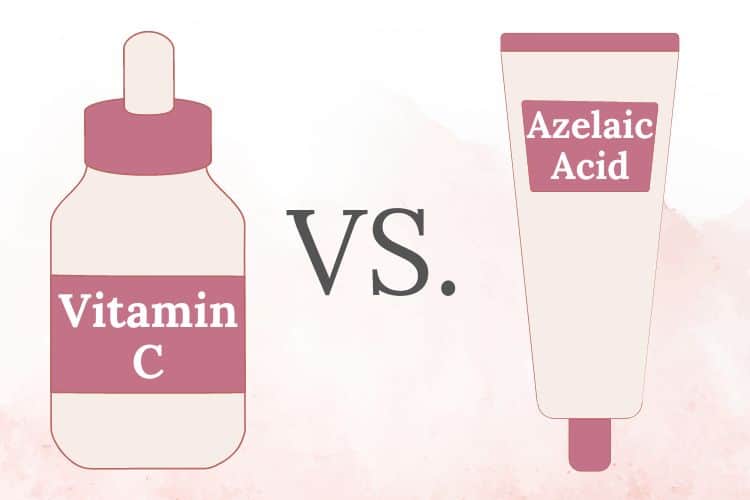
When it comes to skin care actives, azelaic acid and vitamin C are both powerhouses. They do have some similarities, most notably when it comes to their ability to improve hyperpigmentation. As a result, you may be wondering is “azelaic acid or vitamin C better?”
This guide is going to answer that for you by diving into their individual benefits and how to use them (including layering tips).
Let’s get to it!
| AZELAIC ACID | VITAMIN C | |
|---|---|---|
| Anti-inflammatory | ✓ | ✓ |
| Supports collagen production | ✓ | ✓ |
| Helps rosacea | ✓ | ✓ |
| Exfoliates | ✓ | |
| Boosts the effects of sunscreen | ✓ | |
| Improves hyperpigmentation | ✓ | ✓ |
| Suitable for acne-prone skin | ✓ | ✓ |
BENEFITS OF VITAMIN C FOR SKIN

1. Lightens and Brightens Skin
Vitamin C addresses hyperpigmentation by down-regulating the enzyme tyrosinase (which acts as a catalyst in the production of melanin).
By limiting tyrosinase’s activity, vitamin C inhibits melanin synthesis (source).
So, whether you struggle with dark spots, pigmented-scarring from acne or under-eye circles, vitamin C helps you get brighter and more evenly toned skin.
2. Improves Redness
Vitamin C has anti-inflammatory and antioxidant properties that help to reduce redness.
In addition, vitamin C has been shown to seal blood vessels. This benefit seems to also contribute to its ability to soothe redness (source).
All of this makes vitamin C a noteworthy remedy for the swelling and redness that accompanies inflammatory skin conditions (such as acne and rosacea).
3. Prevents Sun Damage
Topical application of vitamin C creates a barrier against sun damage and other environmental pollutants.
In fact, combining vitamin C with your normal sunscreen provides additional UV shielding and a protective boost against harmful environmental toxins (source).
4. Reduces Appearance of Fine Lines and Wrinkles
Vitamin C’s anti-aging reputation is backed by science. It stimulates the activity of cells known as fibroblasts.
These fibroblasts are responsible for producing collagen, elastin and hyaluronic acid. These three compounds are powerhouses for anti-aging!
Combine this with vitamin C’s antioxidant and UV protectant properties, it’s easy to see why this vitamin is one of the most sought after for healthy, youthful skin.
BENEFITS OF AZELAIC ACID FOR SKIN CARE
1. Supports Collagen Production
Azelaic acid gives skin a healthy glow by encouraging cell-turnover, offering gentle exfoliation and evening out skin tone.
Deeper within the skin, azelaic acid increases fibroblast activity. These fibroblasts are responsible for the synthesis of collagen (as well as elastin and hyaluronic acid).
2. Improves Hyperpigmentation
Azelaic is perhaps most famous for fading dark spots. It has anti-pigment properties that disrupt melanin production, thus lessening skin discoloration.
This can be helpful if you have PIH (post-inflammatory hyperpigmentation) or PIE (post-inflammatory erythema).
In fact, studies show azelaic acid can be even more effective than treatments like hydroquinone (source).
3. Reduces Acne Breakouts
Azelaic acid’s reputation for combating acne is well researched and confirmed by various studies (source).
It reduces inflammation and redness associated with painful acne breakouts by inhibiting and killing the bacteria s epidermidis and p acnes.
In addition, azelaic acid has comedolytic properties that stop skin cells and oil from clogging pores (and eventually turning into pimples).
4. Treats Rosacea
Research shows that prescription strength azelaic acid improves rosacea (source).
Most notably, azelaic acid helps with the blemishes and pimples that often occur with rosacea.
Azelaic acid is also used to reduce the redness and swelling associated with rosacea (source).
VITAMIN C VS AZELAIC ACID FOR HYPERPIGMENTATION
Even though vitamin C and azelaic acid are both beneficial for hyperpigmentation, a comparative study revealed that azelaic acid may be superior. In particular, azelaic acid was shown to be more effective for conditions like melasma. As for vitamin C, it can be helpful in preventing PIH (post inflammatory hyperpigmentation) (1, 2).
Interestingly, anecdotal evidence from forums like Reddit show that some people get better results by using these ingredients together (source).
The key seems to lie in ensuring that you’re using a high enough concentration of azelaic acid.
HOW TO USE AZELAIC ACID AND VITAMIN C TOGETHER

1. Use Them Separately
Experts recommend using azelaic acid and vitamin C twice a day – at morning and at night – for the best results (3, 4).
However, remember that both of these ingredients are potent actives.
So, rather than layer them, you may want to use them at different times of the day. This is particularly relevant if you have sensitive skin.
Generally speaking, vitamin C can be used during the day (to boost your sunscreen) while azelaic acid can be used in the evening.
In addition, if you’re brand new to these products, consider using them every other day or every two days, to start.
Then as your skin adapts to them, you can work your way up to daily use.
2. Layer Them Correctly
Azelaic acid and vitamin C make a great team and you do have the option of layering them (if your skin can handle both actives at the same time).
Here are some tips to keep in mind when layering vitamin C and azelaic acid:
- When layering products, apply the lighter or water-based product first. Then apply the heavier (usually oil-based) one next.
- The most common forms of azelaic acid are gels and creams (although there are also foam formulations). As for vitamin C, it’s usually formulated in a water base. Therefore, you will generally apply your vitamin C serum first, followed by azelaic gel or cream.
- Once you’re done layering these products, be sure to apply a moisturizer.
3. Choose the Right Percentage
You can use over-the-counter azelaic acid products (which max out at 10%) or prescription strength (which can go up to 20% concentration).
In either case, research shows that even a 10% concentration is highly effective (source).
As for vitamin C, most people do well with an 8-20% concentration.
However, if you have very sensitive skin, you may be better off with just a 5% concentration.
NOTE: even though there are vitamin C products that go above 20%, they don’t seem to provide better results.
FAQs ABOUT AZELAIC ACID VS VITAMIN C
Can azelaic acid make acne worse?
Although azelaic acid can have an initial purging effect on the skin, it shouldn’t make acne worse.
Actually, its anti-inflammatory properties make it a very helpful treatment for acne, as well as acne-related hyperpigmentation or scarring.
Does vitamin C cause purging?
Vitamin C can cause purging when you first start using it. However, it should eventually subside. If it doesn’t improve after a few weeks, then seek further professional guidance
Is azelaic acid like retinol?
Azelaic acid and retinol have some overlapping properties, but they’re not exactly the same. The most significant difference between them is that azelaic has exfoliating properties, which retinol doesn’t have.
Does azelaic acid damage the skin barrier?
Because azelaic acid can initially cause dryness, itchiness or redness you may think it’s damaging your skin barrier.
In reality, azelaic acid reduces the thickness of the skin’s outer layer but this does not result in damage. It actually improves the smoothness (texture) and quality of the skin (source).
Can you use vitamin C on damaged skin barrier?
Research shows that vitamin C can be used on some people with a compromised skin barrier, such as rosacea patients. However, depending on the extent of your skin barrier damage, vitamin C could be too irritating.
Overall, it’s best to consult your dermatologist for individualized guidance.
Is azelaic acid an AHA or BHA?
Although it is an acid, azelaic acid is neither an AHA or BHA. Azelaic acid has mild exfoliating properties, and can be a gentler option for anyone who finds AHAs or BHAs too harsh.
CONCLUSION
Adding vitamin C or azelaic acid to your skin care routine can help to reduce inflammation, support collagen production and balance your skin tone.
As with all skin care products, you will have to experiment to find which one your skin prefers.
You Might Also Like:
What To Mix (and not) With Vitamin C Serum: A Complete Guide
How To Choose The Best Vitamin C Serum: A Step by Step Guide
Vitamin C Serum vs Rosehip Oil: Benefits, Which Is Better and How To Use
Best Vitamin C Serums for Rosacea (To Soothe Redness and Inflammation)
Vitamin C vs Squalane: Benefits and How to Use Them for Radiant Skin
Best Vitamin C Serums for Dry Skin
Vitamin C Serum Vs Aloe Vera Gel: Which Is Better for Clear Skin?
Best Vitamin C Serum For Sensitive Skin: 5 Products to Unlock Your Natural Glow
What to Combine (and not) With Azelaic Acid for Radiant Skin

